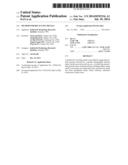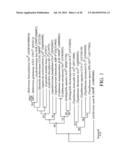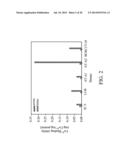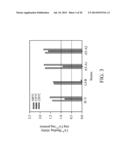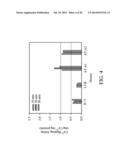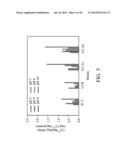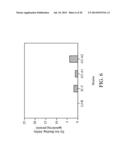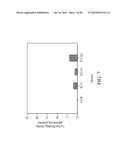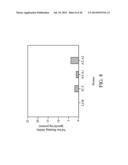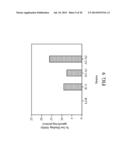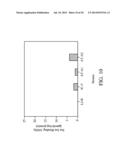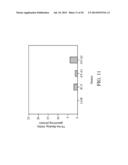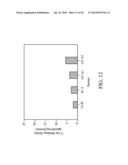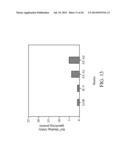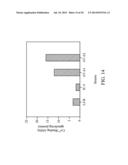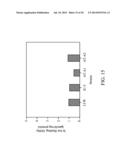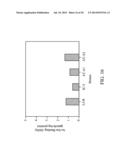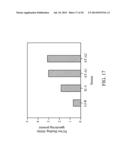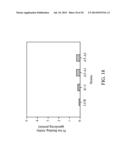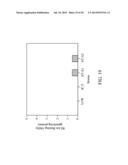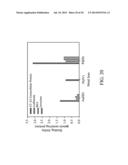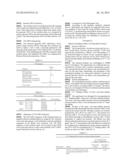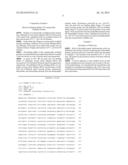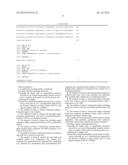Patent application title: METHOD FOR RECYCLING METALS
Inventors:
Yin-Lung Han (Tainan City, TW)
Tai-Rong Guo (Zhubei City, TW)
Jo-Shu Chang (Taichung City, TW)
Yung-Chong Lou (Tainan City, TW)
Wan-Ju Yu (Tainan City, TW)
Assignees:
INDUSTRIAL TECHNOLOGY RESEARCH INSTITUTE
IPC8 Class: AC22B700FI
USPC Class:
423 1
Class name: Chemistry of inorganic compounds treating mixture to obtain metal containing compound
Publication date: 2014-07-10
Patent application number: 20140193316
Abstract:
A method for recycling metals is provided by using extracellular proteins
excreted by a specific thermophilic bacteria strain, Tepidimonas
fonticaldi sp. nov., in which the extracellular proteins show excellent
metal-ion binding ability, being useful in recycling rare earth metal
ions and precious metal ions from geothermal fluids, boiler solutions,
industrial wastewater or hard water.Claims:
1. A method for recycling metals, comprising: providing a liquid
containing metal ions; contacting the liquid with an extracellular
protein(s) excreted by an isolated thermophilic bacteria strain to form a
complex of the metal ion and the protein; and collecting the complex;
wherein the isolated thermophilic bacteria strain is Tepidimonas
fonticaldi sp. nov., internationally deposited in the Korean Collection
of Type Culture (KCTC) with deposit number of KCTC 12528BP.
2. The method of claim 1, further comprising adding a desorption agent to the complex.
3. The method of claim 2, wherein the desorption agent comprises nitrilotriacetic acid (NTA), ethylenediaminetetraacetate (EDTA) or combination thereof.
4. The method of claim 2, wherein the desorption agent comprises sulfate, nitrate, hydrochloric acid or combination thereof.
5. The method of claim 1, wherein the isolated thermophilic bacteria strain comprises 16S rDNA sequence as set forth in SEQ ID NO. 1.
6. The method of claim 1, wherein the metal ion comprises rare earth ions or precious metal ions.
7. The method of claim 6, wherein the rare earth ions comprise cerium (Ce), dysprosium (Dy), erbium (Er), europium (Eu), gadolinium (Gd), holmium (Ho), lanthanum (La), lutetium (Lu), neodymium (Nd), praseodymium (Pr), scandium (Sc), samarium (Sm), terbium (Tb), thorium (Th), thulium (Tm), uranium (U), ytterbium (Yb), yttrium (Y), or combination thereof.
8. The method of claim 6, wherein the precious metal ions comprise gold (Au), silver (Ag), platinum (Pt), palladium (Pd), rhodium (Rh), iridium (Ir) or combination thereof.
9. The method of claim 1, wherein the liquid containing metal ions contacts with the extracellular protein under a temperature of 25.about.100.
10. The method of claim 1, wherein the liquid containing metal ions contacts with the extracellular protein under a pH 2.about.6.
11. The method of claim 1, wherein the liquid containing metal ions comprises geothermal waters, boiler solutions, industrial wastewater or hard water.
12. A method for recycling metals in the treatment of boiler equipment, water pipelines, geothermal wells, industrial wastewater or hard water, wherein the method comprises: providing a liquid containing metal ions; contacting the liquid with an extracellular protein(s) excreted by an isolated thermophilic bacteria strain to form a complex of the metal ion and the protein; and collecting the complex; and wherein the isolated thermophilic bacteria strain is Tepidimonas fonticaldi sp. nov., internationally deposited in the Korean Collection of Type Culture (KCTC) with deposit number of KCTC 12528BP.
Description:
CROSS REFERENCE TO RELATED APPLICATIONS
[0001] This application is a Continuation-In-Part of pending U.S. patent application Ser. No. 13/846,224, filed Mar. 18, 2013 and entitled "NOVEL THERMOPHILIC BACTERIUM AND USES OF EXTRACELLULAR PROTEINS THEREFROM", which claims the benefit of U.S. Provisional Application No. 61/652,522, filed May 29, 2012. The disclosure of the applications is incorporated herein by reference.
INCORPORATION BY REFERENCE OF SEQUENCE LISTING
[0002] A sequence listing submitted as a text file via EFS-Web is incorporated herein by reference. The text file containing the sequence listing is named "0956-A24070-CIP-US_Seq_Listing.txt"; its date of creation is December 20, 2013; and its size is 2,426 bytes.
TECHNICAL FIELD
[0003] The technical field relates to applications of extracellular proteins excreted by thermophilic bacteria.
BACKGROUND
[0004] Geothermal energy is an abundant green energy from the Earth and has potential for development. However, due to its unique components, a change of temperature or pressure may easily cause geothermal fluids to form scales on the wellbore walls or in the formation fractures, which increases the instability of geothermal fluid production.
[0005] An acid or chemical treatment has been internationally used against geothermal scale formation. However, the waste fluids left from the acid or chemical treatment cause severe environmental pollution.
[0006] On the other side, precious metals are not rich in industrial wastewater, geothermal fluids or hot springs. Therefore, to extract precious metals from these liquids by using physical or chemical methods is not efficient and the extraction may cause environmental pollution as mentioned above.
[0007] Thus, development of green energy with high production efficiency, while being environmentally friendly, is being researched more and more.
SUMMARY
[0008] A detailed description is given in the following embodiments with reference to the accompanying drawings.
[0009] In one embodiment, the disclosure provides a method for recycling metals, which comprises providing a liquid containing metal ions, contacting the liquid with an extracellular protein(s) excreted by an isolated thermophilic bacteria strain to form a complex of the metal ion and the protein, and collecting the complex. The isolated thermophilic bacteria strain is Tepidimonas fonticaldi sp. nov., internationally deposited in the Korean Collection of Type Culture (KCTC) with the deposit number of KCTC 12528BP.
BRIEF DESCRIPTION OF THE DRAWINGS
[0010] The present embodiment can be more fully understood by reading the subsequent detailed description and examples with references made to the accompanying drawings, wherein:
[0011] FIG. 1 shows a phylogenic tree diagram of Tepidimonas fonticaldi sp. nov. (AT-A2T), based on the similarity of 16S rDNA, in which "Tepidimonas fonticaldi AT-A2T (JN713899)" represents the strain, Tepidimonas fonticaldi sp. nov., disclosed in the present disclosure;
[0012] FIG. 2 is a bar graph showing the Ca2+ binding ability of intra- and extra-cellular proteins excreted by various thermophilic strains;
[0013] FIG. 3 is a bar graph showing the Ca2+ binding ability of extracellular proteins excreted by various thermophilic strains under different temperature conditions;
[0014] FIG. 4 is a bar graph showing the Ca2+ binding ability of extracellular proteins excreted by various thermophilic strains under different pressure conditions;
[0015] FIG. 5 is a bar graph showing the Ca2+ binding ability of extracellular proteins excreted by various thermophilic strains under different pH value conditions;
[0016] FIG. 6 is a bar graph showing the dysprosium (Dy) ion binding ability of extracellular proteins excreted by various thermophilic strains;
[0017] FIG. 7 is a bar graph showing the lanthanum (La) ion binding ability of extracellular proteins excreted by various thermophilic strains;
[0018] FIG. 8 is a bar graph showing the neodymium (Nd) ion binding ability of extracellular proteins excreted by various thermophilic strains;
[0019] FIG. 9 is a bar graph showing the scandium (Sc) ion binding ability of extracellular proteins excreted by various thermophilic strains;
[0020] FIG. 10 is a bar graph showing the samarium (Sm) ion binding ability of extracellular proteins excreted by various thermophilic strains;
[0021] FIG. 11 is a bar graph showing the ytterbium (Yb) ion binding ability of extracellular proteins excreted by various thermophilic strains;
[0022] FIG. 12 is a bar graph showing the yttrium (Y) ion binding ability of extracellular proteins excreted by various thermophilic strains;
[0023] FIG. 13 is a bar graph showing the barium (Ba) ion binding ability of extracellular proteins excreted by various thermophilic strains; and
[0024] FIG. 14 is a bar graph showing the calcium ion (Ca2+) binding ability of extracellular proteins excreted by various thermophilic strains.
[0025] FIG. 15 is a bar graph showing the indium ion (In) binding ability of extracellular proteins excreted by various thermophilic strains.
[0026] FIG. 16 is a bar graph showing the gold ion (Au) binding ability of extracellular proteins excreted by various thermophilic strains.
[0027] FIG. 17 is a bar graph showing the palladium ion (Pd) binding ability of extracellular proteins excreted by various thermophilic strains.
[0028] FIG. 18 is a bar graph showing the platinum ion (Pt) binding ability of extracellular proteins excreted by various thermophilic strains.
[0029] FIG. 19 is a bar graph showing the rhodium ion (Rh) binding ability of extracellular proteins excreted by various thermophilic strains.
[0030] FIG. 20 is a bar graph showing the gold ion (Au) binding ability and the palladium ion (Pd) binding ability of the extracellular protein excreted by Tepidimonas fonticaldi sp. nov. (AT-A2 extracellular protein) and commercially available proteins (ovalbumin, BSA and lysozyme).
DETAILED DESCRIPTION
[0031] In the following detailed description, for purposes of explanation, numerous specific details are set forth in order to provide a thorough understanding of the disclosed embodiments. It will be apparent, however, that one or more embodiments may be practiced without these specific details. In other instances, well-known structures and devices are schematically shown in order to simplify the drawing.
[0032] In one embodiment, the present disclosure uses a thermophilic bacteria strain isolated and purified from hot spring water at the Antun, Hualien County, Taiwan. The isolated thermophilic bacteria strain, after being analyzed and sequenced, shows a sequence of the 16S ribosomal DNA (rDNA) as set forth in SEQ ID No. 1. According to the sequence of the 16S rDNA, the isolated strain (AT-A2T) shows phylogenetically close to the well-known strains, Tepidimonas thermarum AA-1T (97.5% sequence similarity), Tepidimonas aquatica CLN-1T (96.8% sequence similarity), Tepidimonas ignava SPS-1037T (96.4% similarity) and Tepidimonas taiwanensis I1-1T (95.8% sequence similarity). A phylogenetic tree diagram based on the sequence similarity of 16S rDNA is depicted in FIG. 1.
[0033] The 16S rDNA sequences of the isolated thermophilic strain (AT-A2T) and Tepidimonas thermarum AA-1T were made to hybridize. A DNA-DNA relatedness was shown as 23.9±0.2%, indicating that the isolated thermophilic strain (AT-A2T) belonged to Tepidimonas sp.
[0034] On the biological characteristics, the isolated thermophilic bacteria strain (AT-A2T) shows aerobic and Gram negative, and forms non-pigmented colonies and mobiles by a single polar flagellum. An optimal growth occurs at 35˜60° C., or 55° C., at 0˜1.0 wt % of NaCl, or 0.2 wt % of NaCl, and under a pH 7.0˜9.0, or pH 7.0. The predominant cellular fatty acids of the isolated thermophilic strain include C16:0 (40.2%), summed feature 3 (C16:1 ω7c and/or C16:1 ω6c; 20.1%) and C17:0 cyclo (11.5%). The major polar fatty acids include phosphatidylethanolamine (PE) and phosphatidylglycerole (PG). The GC content of the total DNA in one cell of the bacterium is 70.1 mol %.
[0035] On the basis of the phylogenetic and phenotypic data, the isolated strain is classified as a novel species and named as Tepidimonas fonticaldi sp. nov., internationally deposited in the Korean Collection of Type Culture (KCTC) on Dec. 4, 2013 with the deposit number of KCTC 12528BP.
[0036] The extracellular protein excreted by Tepidimonas fonticaldi sp. nov. shows excellent binding ability to metal ions under appropriate conditions. The metal ion comprises rare earth ions or precious metal ions. The rare earth ion may comprise cerium (Ce), dysprosium (Dy), erbium (Er), europium (Eu), gadolinium (Gd), holmium (Ho), lanthanum (La), lutetium (Lu), neodymium (Nd), praseodymium (Pr), scandium (Sc), samarium (Sm), terbium (Tb), thorium (Th), thulium (Tm), uranium (U), ytterbium (Yb), yttrium (Y), or combination thereof. The precious metal ion may comprise gold (Au), silver (Ag), platinum (Pt), palladium (Pd), rhodium (Rh), iridium (Ir) or combination thereof.
[0037] In addition, the extracellular protein excreted by Tepidimonas fonticaldi sp. nov. shows excellent binding ability to metal ions, such as bi- or tri-valent metal ions, under appropriate conditions. The bi- or tri-valent metal ions may comprise aluminium (Al), boron (B), barium (Ba), bismuth (Bi), calcium (Ca), cadmium (Cd), cobalt (Co), chromium (Cr), copper (Cu), iron (Fe), gallium (Ga), indium (In), potassium (K), lithium (Li), magnesium (Mg), manganese (Mn), sodium (Na), nickel (Ni), lead (Pb), strontium (Sr), thallium (Tl), zinc (Zn) or combination thereof, but are not limited thereto.
[0038] According to the present disclosure, the metal-ion binding ability of the extracellular protein excreted by Tepidimonas fonticaldi sp. nov. is not affected by high temperatures, high pressure and/or extreme pH conditions. Specifically, in one example, the extracellular proteins show excellent metal ion binding ability under 100, pH 7. In another example, the extracellular proteins show excellent metal ion binding ability under a temperature of 75˜150° C., preferably 125˜150° C., at 1 atm, pH 7. In another example, the extracellular proteins show excellent metal ion binding ability at a pressure of 1˜50 atm, preferably 30˜50 atm, at 25° C., pH 7. In another example, the extracellular proteins show excellent metal ion binding ability at acidic condition, like pH 2˜6 or basic condition, like pH 7˜10, at 25° C., 1 atm.
[0039] According to the present disclosure, the method for recycling metals further comprises a step of adding a desorption agent to the complex. The desorption agent causes the metal ion being desorbed from the complex consisted of the extracellular protein and the metal ion. In one example, the desorption agent may comprise nitrilotriacetic acid (NTA), ethylenediaminetetraacetate (EDTA), or combination thereof. In another example, the desorption agent may comprise sulfate, nitrate, hydrochloric acid or combination thereof.
[0040] Due to the excellent metal ion binding ability, the extracellular protein according to the present disclosure is able to bind metal ions in the liquid, such as geothermal waters, boiler solutions, industrial wastewater or hard water, in particular, in order to absorb metal ions for recycling the metals. Therefore, the method according to the present disclosure can reduce the pollution of the liquid, like industrial wastewater, and increase the concentration of the metal ions in the wastewater so as to reduce the cost of recycling the metals from the liquid, resulting in an efficient metal recycling.
[Example 1]
Collection and Identification of Tepidimonas Fonticaldi sp. nov.
[0041] Collection
[0042] 10 L of the hot spring water at the Antun, Hualien County, Taiwan was collected with an aluminum foil-wrapped bottle. The collected hot spring water was filtered through a 0.45pm filter membrane under a sterile condition. The filter membrane was then put onto a 1.5% agarose medium (a mixture of 300 mL of hot spring water and 4.5 g of agarose, under 121° C., heated for 15 minutes and added into a medium plate for cooling) and cultured at 55° C. for 7˜14 days. After being cultured, colonies with various colors or shapes were picked up with a sterile inoculating loop and lined on a fresh agarose medium. The steps above were repeated to obtain a pure strain. The isolated strain was stored at 4° C.
[0043] Bacteria DNA Extraction
[0044] The isolated strain was picked up from the medium with a sterile inoculating loop and added into 1 mL of sterile water. After three times of being washed with sterile water, the genomic DNA of the isolated strain was extracted by using a genomic DNA extraction minoprep system (Blood & Tissue). The extracted genomic DNA was then stored at -20° C.
[0045] 16S rDNA Sequencing
[0046] The extracted genomic DNA underwent a polymerase chain reaction (PCR) following the conditions set forth in Tables 1 and 2 with a universal prokaryotic 16S ribosome PCR primer pair of FD1 (SEQ ID NO. 2) and RD1 (SEQ ID NO. 3) for amplifying the 16S rDNA sequence of the isolated strain. The amplified 16S rDNA was sequenced by Mission Biotech Incorporation, Taiwan.
TABLE-US-00001 TABLE 1 PCR Reagents Volume Reagents (μl) DNA templates 1 Tag buffer (10X) 2.5 Tag polymerase (2.5 U/μl) 0.125 dNTP (2.5 mM) 2 Forward primer (100 pmol/μl) 1 Reverse primer (100 pmol/μl) 1 deionized water 17.5 Total volume 25
TABLE-US-00002 TABLE 2 PCR Conditions Temperature and time Reaction Cycle numbers Stage 1 95° C. 5 min Denature 1 Stage 2 95° C. 1 min Denature 35 56° C. 1 min Annealing 72° C. 1 min Extending Stage 3 72° C. 4 min Extending 1
[0047] Alignment of 16S rDNA Sequence
[0048] The 16S rDNA sequence of the isolated strain was aligned with the GenBank library by using BLAST software (www.ncbi.nlm.nih.gov) and similarities with the published sequences in the library were analyzed. The 16S DNA sequence of the isolated strain was recorded in the NCBI (www.ncbi.nlm.nih.gov) with a series number of JN 713899, named Tepidimonas fonticaldi sp. nov.
[0049] Construction of the Phylogenic Tree
[0050] According to the sequence similarity obtained above, a phylogenic tree diagram was depicted with accession numbers of each strain by using BioEdit software and CLUSTAL_X and homology among these strains was calculated as well. The phylogenic tree diagram is shown in FIG. 1, in which the isolated strain was identified as Tepidimonas fonticaldi sp. nov. (AT-A2T)
[Example 2]
Metal Ion Binding Ability of Extracellular Proteins
[0051] Protein Collection
[0052] The isolated strain, Tepidimonas fonticaldi sp. nov., and a modal strain, Thermus aquaticus BCRC 17110, were respectively inoculated in a 100 mL 1/10 TSB medium (1.7 g/L pancreatic digest of casein, 0.3 g/L enzymatic digest of soybean meal, 0.25 g/L dextrose, 0.5 g/L NaCl and 0.25 g/L dipotassium phosphate) and cultured at 200 rpm, at 55° C. for 3˜5 days.
[0053] The cultured medium was centrifuged at 10,000 rpm for 10 minutes. The supernatant was collected and concentrated by 10 times with a protein concentration system. The concentrated protein was taken as the extracellular proteins for the next steps. Meanwhile, the precipitate of the centrifuged medium was ultrasound vibrated to break the bacteria and the solution was taken as the intracellular proteins for the next steps.
[0054] Protein Quantification
[0055] The extracellular proteins solution obtained above 100 μL were added with a Bio-Rad protein test reagent 400 μL for a color reaction, occurring within 15 minutes. The absorbance at a wavelength of 595 nm was detected and the protein concentration was calculated.
[0056] Ca2+ Binding Ability of Extra- and Intra-cellular Proteins
[0057] The experiment was designed for investigating the Ca2+ binding ability of the extra- and intra-cellular proteins. The extra- and intra-cellular proteins from the thermophilic bacteria listed in Table 3 were all detected for the Ca2+ binding ability.
[0058] 50 ppm of the extra- and intra-cellular proteins obtained from the thermophilic bacteria listed in Table 3 were respectively mixed with the 100 ppm calcium ion solution prepared by CaCl2.2H2O in a ratio of 1:1. The mixture was heated in 100° C. of a water bath for 1 hour. The mixture was then filtered through an ultrafiltration system with a 3 KDa membrane to capture the proteins. The filtrate was then diluted with deionized water to reach the detection limit (0˜5 ppm). The Ca2+ concentration left in the filtrate was analyzed by an inductively coupled plasma atomic emission spectrometer (ICP-AES) for calculating the Ca2+ binding ability. The results are shown in Table 3 and FIG. 2.
TABLE-US-00003 TABLE 3 Ca2+ Binding Ability of Extra- and Intra-Cellular Proteins Ca2+ binding ability (mg Ca2+/mg protein) Intracellular Extracellular Strain codes Strains protein protein IC-5 98.764% of 16S DNA similarity with 0.012 0.034 Anoxybacillus kamchatkensis JW/VK- KG4T LJ-B 98.949% of 16S DNA similarity with 0.005 0.069 Anoxybacillus mongoliensis T4T AT-A1 100.00% of 16S DNA similarity with 0.006 0.032 Meiothermus ruber DSM 1279T AT-A2 Tepidimonas fonticaldi sp. nov. 0.011 0.327 BCRC 17110 Thermus aquaticus BCRC 17110 0.005 0.082
[0059] As shown in Table 3 and FIG. 2, the Ca2+ binding ability of the extracellular proteins was much more significant than that of the intracellular proteins. Meanwhile, the extracellular proteins of the thermophilic bacteria strain, Tepidimonas fonticaldi sp. nov. (AT-A2T), showed 0.327 mg of Ca2+/mg protein, the best binding ability among these strains. Regarding the other strains, the extracellular proteins merely showed Ca2+ binding ability of less than 0.1 mg of Ca2+/mg protein.
[0060] Ca2+ Binding Ability Under Various Conditions
[0061] An experiment was designed for investigating the effects of environmental factors, like temperature, pressure, pH value etc., on the Ca2+ binding ability of the extracellular proteins from some of the thermophilic bacteria strains listed in Table 3.
[0062] The experiment included the three following groups:
[0063] Group 1: The extracellular proteins 50 ppm were treated respectively under a pressure of 10 atm, 30 atm and 50 atm, at 25° C., pH 7 for 10 minutes;
[0064] Group 2: The extracellular proteins 50 ppm were treated respectively under a pH 2, pH 4, pH 6, pH 7, pH 8 and pH 10 at 25° C., 1 atm for 10 minutes; and
[0065] Group 3: The extracellular proteins 50ppm were treated respectively under a temperature of 100° C., 125° C., and 150° C., at 1 atm, pH 7 for 10 minutes.
[0066] The treated proteins 50 ppm were separately mixed with a 100 ppm calcium ion solution prepared by CaCl2.2H2O in a ratio of 1:1. The mixture was heated in a 100° C. water bath for 10 minutes. The mixture was then filtered through an ultrafiltration system with a 3 KDa membrane to capture the proteins. The filtrate was then diluted with deionized water to reach the detection limit (0˜5 ppm). The Ca2+ concentration left in the filtrate was analyzed by an inductively coupled plasma atomic emission spectrometer (ICP-AES) for calculating the Ca2+ binding ability. The results are shown in FIGS. 3˜5.
[0067] In FIGS. 3˜5, the extracellular proteins from the thermophilic bacteria strain, Tepidimonas fonticaldi sp. nov. (AT-A2T), showed excellent Ca2+ binding ability under high temperatures, high pressure and broad pH values.
[0068] Rare Earth Ion Binding Ability
[0069] An experiment was designed for investigating the rare earth ion binding ability of the extracellular proteins excreted by some of the thermophilic bacteria strains listed in Table 3.
[0070] The extracellular proteins 10 ppm were mixed with a standard solution 10 ppm in a ratio of 1:1 and reacted at 100° C., pH 2 for 20 minutes. The standard solution included metal ions of cerium (Ce), dysprosium (Dy), erbium (Er), europium (Eu), gadolinium (Gd), holmium (Ho), lanthanum (La), lutetium (Lu), neodymium (Nd), praseodymium (Pr), scandium (Sc), samarium (Sm), terbium (Tb), thorium (Th), thulium (Tm), uranium (U), ytterbium (Yb) and yttrium (Y).
[0071] The binding abilities of dysprosium (Dy), lanthanum (La), neodymium (Nd), scandium (Sc), samarium (Sm), ytterbium (Yb) and yttrium (Y) were determined by using the method described above and were shown in a unit of μmole metal ions/mg proteins in FIGS. 6˜12, respectively.
[0072] Bi- and Tri-Valent Metal Ion Binding Ability
[0073] An experiment was designed for investigating the bi- and tri-valent metal ion binding ability of the extracellular proteins from some of the thermophilic bacteria strains listed in Table 3.
[0074] The extracellular proteins 10 ppm were mixed with a standard solution 10 ppm in a ratio of 1:1 and reacted at 100° C., pH 2 for 20 minutes. The standard solution included metal ions of aluminium (Al), boron (B), barium (Ba), bismuth (Bi), calcium (Ca), cadmium (Cd), cobalt (Co), chromium (Cr), copper (Cu), iron (Fe), gallium (Ga), indium (In), potassium (K), lithium (Li), magnesium (Mg), manganese (Mn), sodium (Na), nickel (Ni), lead (Pb), strontium (Sr), thallium (Tl) and zinc (Zn). The binding abilities of barium (Ba) ions, calcium (Ca) ions and indium (In) ions were determined by using the method described above and were shown in a unit of μmole metal ions/mg protein in FIGS. 13˜15, respectively.
[0075] Precious Metal Ion Binding Ability
[0076] An experiment was designed for investigating the precious metal ion binding ability of the extracellular proteins excreted by some of the thermophilic bacteria strains listed in Table 3.
[0077] The extracellular proteins 10 ppm were mixed with a standard solution 10 ppm in a ratio of 1:1 and reacted at 100° C., pH 2 for 20 minutes. The standard solution included metal ions of gold (Au), palladium (Pd), platinum (Pt) and rhodium (Rh). The binding abilities of these ions were determined by using the method described above and were shown in a unit of μmole metal ions/mg protein in FIGS. 16˜19, respectively.
[0078] As given in FIGS. 6˜19, the extracellular proteins from the thermophilic bacteria strain, Tepidimonas fonticaldi sp. nov. (AT-A2T), show excellent binding ability broadly to rare earth ions, bi- and tri- valent metal ions and precious metal ions.
Comparative Example 1
Metal Ion Binding Ability Of Commercially Available Proteins
[0079] 50 ppm of commercially available proteins including ovalbumin, bovine serum albumin (BSA) and lysozyme were mixed with a palladium (Pd) ion standard solution 10 ppm and reacted at 25° C., pH 4 for 60 minutes.
[0080] On the other side, 50 ppm of commercially available proteins including ovalbumin, bovine serum albumin (BSA) and 100 ppm of lysozyme were mixed with a gold (Au) ion standard solution 10 ppm and reacted at 25° C., pH 4 for 60 minutes.
[0081] The binding ability of the commercially available proteins was determined by the method described in Example 2 and was shown in a unit of μmole metal ions/mg protein.
[0082] As given in FIG. 20, the gold (Au) ion binding ability of ovalbumin, bovine serum albumin (BSA) and lysozyme is 0.18, 0.20 and 0.10 μmole metal ions/mg protein, respectively. The palladium (Pd) ion binding ability of ovalbumin, bovine serum albumin (BSA) and lysozyme is 0.86, 0.98 and 0.98μmole metal ions/mg protein, respectively. Meanwhile, the extracellular proteins from the thermophilic bacteria strain, Tepidimonas fonticaldi sp. nov. (AT-A2T), show the gold (Au) ion binding ability being 1.33 μmole metal ions/mg protein and the palladium (Pd) ion binding ability being 3.13 μmole metal ions/mg protein in the same figure. These results show that the extracellular proteins from the thermophilic bacteria strain, Tepidimonas fonticaldi sp. nov. (AT-A2T), have better precious metal ion binding ability than the commercially available ones.
Example 3
Desorption of Metal Ions
[0083] 40 ml of desorption agent, nitrilotriacetic acid, was added into the reaction systems comprising the extracellular proteins and rare earth ions or precious metal ions described in Example 2. The reactants were desorbed at 25° C. for 30 min. The metals in each reaction systems were then collected respectively.
[0084] It will be apparent to those skilled in the art that various modifications and variations can be made to the disclosed embodiments. It is intended that the specification and examples be considered as exemplary only, with a true scope of the disclosure being indicated by the following claims and their equivalents.
Sequence CWU
1
1
311276DNATepidimonas thermarum AA-1 1gggtgctgac gagtggcgaa cgggtgagta
atgcatcgga acgtgcccag aggtggggga 60taacgcagcg aaagctgtgc taataccgca
tgtgatctga ggatgaaagc gggggaccaa 120gcagcaatgt ttggcctcgc gcctctggag
cggccgatgt cagattaggt agttggtggg 180gtaaaggcct accaagccga cgatctgtag
ctggtctgag aggacgacca gccacactgg 240gactgagaca cggcccagac tcctacggga
ggcagcagtg gggaattttg gacaatgggc 300gcaagcctga tccagcaatg ccgcgtgcgg
gaagaaggcc ttcgggttgt aaaccgcttt 360tgtacggaac gaaaaggctc tggctaatac
ctggggctga tgacggtacc gtaagaataa 420gcaccggcta actacgtgcc agcagccgcg
gtaatacgta gggtgcgagc gttaatcgga 480attactgggc gtaaagcgtg cgcaggcggt
cttgtaagac agaggtgaaa tccctgggct 540caacctagga atggcctttg tgactgcaag
gctggagtgc ggcagagggg gatagaattc 600cgcgtgtagc agtgaaatgc gtagatatgc
ggaggaacac cgatggcgaa ggcagtcccc 660tgggcctgca ctgacgctca tgcacgaaag
cgtggggagc aaacaggatt agataccctg 720gtagtccacg ccctaaacga tgtcgactgg
ttgttgggcc ttaggtggct cagtaacgaa 780gctaacgcgt gaagtcgacc gcctggggag
tacggccgca aggttgaaac tcaaaggaat 840tgacggggac ccgcacaagc ggtggatgat
gtggtttaat tcgatgcaac gcgaaaaacc 900ttacctaccc ttgacatgcc aggaatcctg
cagagatgtg ggagtgctcg caagagagcc 960tggacacagg tgctgcatgg ctgtcgtcag
ctcgtgtcgt gagatgttgg gttaagtccc 1020gcaacgagcg caacccttgc cattagttgc
tacgaaaggg cactctaatg ggactgccgg 1080tgacaaaccg gaggaaggtg gggatgacgt
caagtcctca tggcccttat gggtagggct 1140acacacgtca tacaatggcc ggtacagagg
gctgccaacc cgcgaggggg agccaatccc 1200gtaaaaccgg tcgtagtccg gattgcagtc
tgcaactcga ctgcatgaag tcggaatcgc 1260tagtaatcgc ggatca
1276220DNAArtificial Sequencesynthetic
oligonucleotide 2agagtttgat cctggctcag
20317DNAArtificial Sequencesynthetic oligonucleotide
3aaggaggtga tccagcc 17
User Contributions:
Comment about this patent or add new information about this topic:

